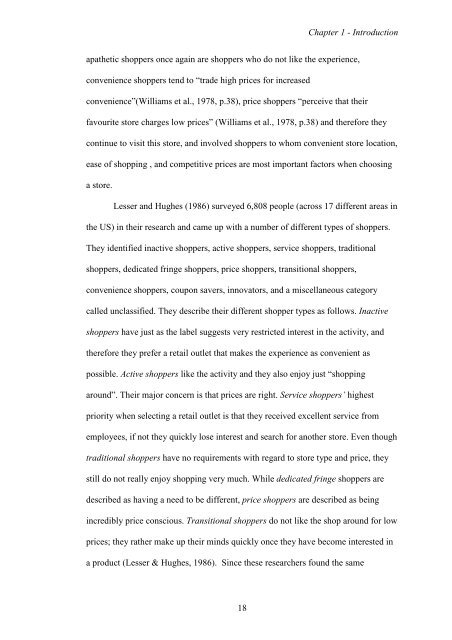CHAPTER 1 - University of Exeter
CHAPTER 1 - University of Exeter
CHAPTER 1 - University of Exeter
Create successful ePaper yourself
Turn your PDF publications into a flip-book with our unique Google optimized e-Paper software.
18<br />
Chapter 1 - Introduction<br />
apathetic shoppers once again are shoppers who do not like the experience,<br />
convenience shoppers tend to “trade high prices for increased<br />
convenience”(Williams et al., 1978, p.38), price shoppers “perceive that their<br />
favourite store charges low prices” (Williams et al., 1978, p.38) and therefore they<br />
continue to visit this store, and involved shoppers to whom convenient store location,<br />
ease <strong>of</strong> shopping , and competitive prices are most important factors when choosing<br />
a store.<br />
Lesser and Hughes (1986) surveyed 6,808 people (across 17 different areas in<br />
the US) in their research and came up with a number <strong>of</strong> different types <strong>of</strong> shoppers.<br />
They identified inactive shoppers, active shoppers, service shoppers, traditional<br />
shoppers, dedicated fringe shoppers, price shoppers, transitional shoppers,<br />
convenience shoppers, coupon savers, innovators, and a miscellaneous category<br />
called unclassified. They describe their different shopper types as follows. Inactive<br />
shoppers have just as the label suggests very restricted interest in the activity, and<br />
therefore they prefer a retail outlet that makes the experience as convenient as<br />
possible. Active shoppers like the activity and they also enjoy just “shopping<br />
around”. Their major concern is that prices are right. Service shoppers’ highest<br />
priority when selecting a retail outlet is that they received excellent service from<br />
employees, if not they quickly lose interest and search for another store. Even though<br />
traditional shoppers have no requirements with regard to store type and price, they<br />
still do not really enjoy shopping very much. While dedicated fringe shoppers are<br />
described as having a need to be different, price shoppers are described as being<br />
incredibly price conscious. Transitional shoppers do not like the shop around for low<br />
prices; they rather make up their minds quickly once they have become interested in<br />
a product (Lesser & Hughes, 1986). Since these researchers found the same
















